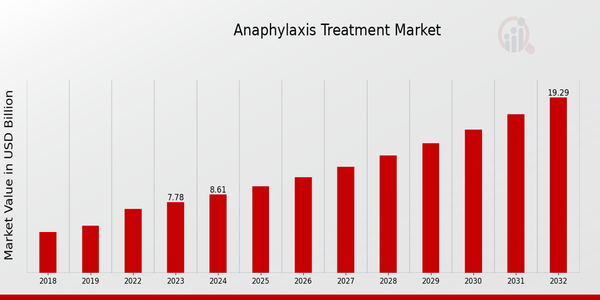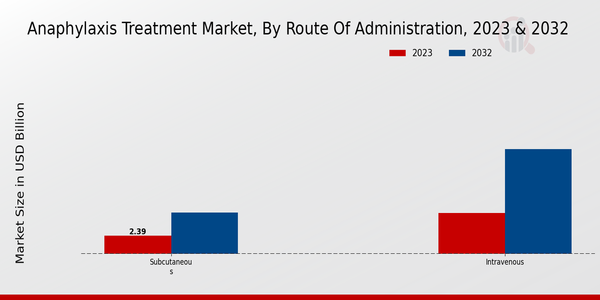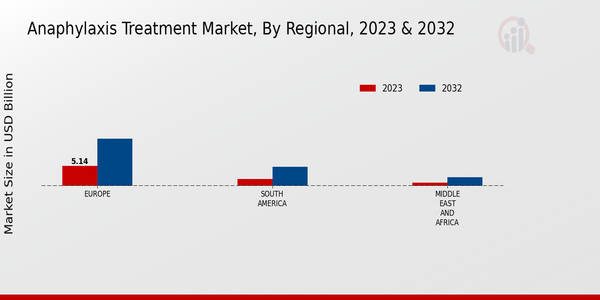Global Anaphylaxis Treatment Market Overview
As per MRFR analysis, the anaphylaxis treatment market size was estimated at 1.59 (USD Billion) in 2023. The anaphylaxis treatment market industry is expected to grow from 1.77 (USD Billion) in 2024 to 3.85 (USD Billion) by 2032. The anaphylaxis treatment market CAGR (growth rate) is expected to be around 9.00% during the forecast period (2024 - 2032).
Key Anaphylaxis Treatment Market Trends Highlighted
The global anaphylaxis treatment market is experiencing significant advancements in recent times. Key drivers fueling growth include rising prevalence of allergic reactions, increasing awareness of anaphylaxis, and advancements in diagnostic and treatment methodologies. Opportunities lie in the exploration of novel therapies, personalized treatment approaches, and the development of effective epinephrine auto-injectors.
Moreover, advancements in devices such as smart pens and wearable injectors are enhancing patient convenience and improving treatment adherence. The market is also witnessing the emergence of innovative technologies like AI and machine learning, which are enabling the development of predictive models and personalized treatment plans. Furthermore, collaborations between pharmaceutical companies, research institutions, and patient advocacy groups are driving innovation and expanding market reach.

Source: Primary Research, Secondary Research, MRFR Database and Analyst Review
Anaphylaxis Treatment Market Drivers
Rising Prevalence of Anaphylaxis
Anaphylaxis is a severe and likely life-threatening allergic reaction that can be caused by several substances, such as different foods, insect stings, and medication. One of the leading drivers of the global anaphylaxis treatment market can be thought of as the growing prevalence of anaphylaxis.
Changing lifestyles and eating patterns might be causing an increase, as well as an increased understanding of exactly what anaphylaxis is and technological advances in diagnoses. Over the next several years, the incidence of anaphylaxis is expected to continue to grow, increasing the demand for effective treatments.
Technological Advancements in Anaphylaxis Treatment
The global anaphylaxis treatment market is continuously changing, with new technologies and therapies emerging to increase the efficiency of anaphylaxis treatment. Advancements within the market include new epinephrine auto-injectors, system improvements to antihistamines and corticosteroids delivery, and the development of new therapeutic models.
It is stated that technological advancements are likely to shape the future of the industry and provide the tools needed to improve treatment efficacy and accessibility, ultimately impacting the market.
Increasing Awareness and Education about Anaphylaxis
Raising awareness about anaphylaxis and educating individuals, healthcare professionals, and the public about its signs, symptoms, and management is crucial for improving patient outcomes. Educational campaigns and initiatives have been implemented to increase understanding of anaphylaxis, promote early recognition and intervention, and reduce the risk of severe reactions.
Enhanced awareness and education contribute to the growing demand for anaphylaxis treatment products and services, as individuals seek to prepare for and manage anaphylaxis effectively.
Anaphylaxis Treatment Market Segment Insights
Anaphylaxis Treatment Route of Administration Insights
The global anaphylaxis treatment market is segmented into various categories based on route of administration, including intramuscular, subcutaneous, and intravenous. Each route offers unique advantages and considerations for the delivery of anaphylaxis treatment.
Intramuscular injections are commonly used for the administration of epinephrine, the first-line treatment for anaphylaxis. Epinephrine auto-injectors, such as EpiPen and Auvi-Q, are designed for intramuscular delivery, providing rapid absorption and onset of action. This route of administration is preferred in emergency situations where immediate intervention is crucial.
Subcutaneous injections offer an alternative route for the delivery of anaphylaxis treatment. They are typically used for the administration of antihistamines and corticosteroids, which are used to manage allergic reactions and reduce inflammation.
Subcutaneous injections provide slower absorption compared to intramuscular injections, but they can be more convenient and less painful. Intravenous administration is another route used for the delivery of anaphylaxis treatment. It involves the injection of medications directly into a vein, providing the fastest and most effective delivery.
This route is typically used in severe cases of anaphylaxis or when other routes are not feasible. The choice of route of administration for anaphylaxis treatment depends on various factors, including the severity of the reaction, the patient's condition, and the availability of different devices and medications. Intramuscular injections are preferred for emergency situations, while subcutaneous and intravenous injections may be more appropriate for ongoing management of allergic reactions.
The global anaphylaxis treatment market is expected to witness steady growth in the coming years, driven by increasing prevalence of allergies, rising awareness about anaphylaxis, and the development of new and more effective treatment options. Key industry players are investing in research and development to expand their product portfolio and cater to the evolving needs of patients with anaphylaxis.

Source: Primary Research, Secondary Research, MRFR Database and Analyst Review
Anaphylaxis Treatment Treatment Type Insights
The global anaphylaxis treatment market segmentation by treatment type comprises of self-injectable and conventional treatment. Self-Injectable epinephrine devices, such as EpiPens and Auvi-Qs, have gained significant traction due to their ease of use and portability.
The demand for self-injectable epinephrine devices is projected to hold a dominant share in the market, driven by increased awareness and adoption of self-medication. Conventional Treatment involves administering epinephrine injections in a clinical setting by a healthcare professional.
This method is commonly used in severe anaphylaxis cases requiring immediate medical intervention. Despite the convenience of self-injectable devices, conventional treatment remains essential in emergency situations where immediate medical attention is necessary.
Anaphylaxis Treatment Device Type Insights
The device type segment of the global anaphylaxis treatment market consists of auto-injectors, pre-filled syringes, and vials. Auto-Injectors hold the dominant market share due to their ease of use and portability. In 2023, the auto-Injectors segment was valued at USD 4.2 billion and is projected to reach USD 7.4 billion by 2032, exhibiting a CAGR of 7.1%.
Pre-filled syringes offer accurate dosing and are preferred in hospital settings. This segment is anticipated to grow at a CAGR of 6.5% during the forecast period, reaching a value of USD 3.2 billion by 2032. Vials, on the other hand, are cost-effective but require manual administration. The vials segment is expected to register a CAGR of 5.8%, reaching a value of USD 2.6 billion by 2032.
Overall, the device type segment plays a crucial role in the delivery of anaphylaxis treatment, with each device type catering to specific patient needs and preferences.
Anaphylaxis Treatment Allergen Type Insights
The global anaphylaxis treatment market is segmented by allergen type into food allergies, insect allergies, drug allergies, and latex allergies. Among these segments, food allergies account for the largest share of the market. In 2023, the food allergies segment is valued at USD 2.8 billion and is projected to reach USD 7.2 billion by 2032, exhibiting a CAGR of 10.6%.
The high prevalence of food allergies, particularly among children, is a major factor driving the growth of this segment. Additionally, the development of new and innovative treatments for food allergies, such as oral immunotherapy, is expected to further boost market growth.
Anaphylaxis Treatment Age Group Insights
The global anaphylaxis treatment market is segmented by age group into Pediatric and Adult. The Pediatric segment is expected to account for a larger share of the market in 2023, owing to the higher prevalence of anaphylaxis in children.
However, the adult segment is expected to grow at a faster CAGR during the forecast period, due to the increasing incidence of anaphylaxis in adults. In 2023, the Pediatric segment is expected to be valued at USD 3.2 billion, while the adult segment is expected to be valued at USD 4.5 billion.
By 2032, the pediatric segment is expected to reach USD 7.2 billion, while the adult segment is expected to reach USD 12.1 billion. The growth of the adult segment is attributed to the increasing prevalence of food allergies and other triggers of anaphylaxis in adults, as well as the growing awareness of anaphylaxis and its treatment.
Anaphylaxis Treatment Regional Insights
The global anaphylaxis treatment market is segmented into North America, Europe, APAC, South America, and MEA. North America is expected to hold the largest market share due to the high prevalence of anaphylaxis and the presence of key market players.
Europe is expected to be the second-largest market, followed by APAC. The APAC region is expected to witness the highest growth rate due to the increasing awareness of anaphylaxis and the growing number of healthcare facilities. South America and MEA are expected to have a relatively smaller market share due to the lower prevalence of anaphylaxis and limited access to healthcare facilities.

Source: Primary Research, Secondary Research, MRFR Database and Analyst Review
Anaphylaxis Treatment Market Key Players and Competitive Insights
Major players in the anaphylaxis treatment market are constantly competing to increase their overall market share by innovating products. Chief anaphylaxis treatment market players are focusing on the offered improved and safer product.
This anaphylaxis treatment market has become popular over the years, as companies are trying to cater to the demand for effective and safe anaphylaxis treatment. A prime example of this anaphylaxis treatment market trend is Mylan N.V.
Mylan N.V. is an established participant in the anaphylaxis treatment market that has an extensive product portfolio. The company offers various anaphylaxis treatments, such as epinephrine auto-injectors and oral antihistamines. These products are branded and available under several names, such as EpiPen, EpiPen Jr., and Auvi -Q. Mylan N.V. is one of the leading Anaphylaxis Treatment Market companies with its strong distribution network and a high customer base. Additionally, the company benefits from a strong brand. Despite these overall positive characteristics, Mylan N.V. also faces a strong competitor in the anaphylaxis treatment market, which is itself a player that can be an example of the overall anaphylaxis treatment market.
Mylan N.V.’s competitors in the market are companies such as Sanofi. Sanofi’s product portfolio is similar to that of Mylan N.V. as the company offers different anaphylaxis treatments, such as epinephrine auto-injectors and oral antihistamines. These products, including Anapen and Twinject, are available under various brands.
Additionally, Sanofi is a powerful player in the Anaphylaxis Treatment Market that has a strong presence on the European continent and is continually expanding to oversee more regions. Moreover, the company has a strong research and development base.
Key Companies in the Anaphylaxis Treatment Market Include
- Johnson and Johnson
- AstraZeneca
- Novartis
- Pfizer
- Xeris Pharmaceuticals
- Mylan
- Amgen
- GlaxoSmithKline
- AbbVie
- Coherus BioSciences
- BristolMyers Squibb
- Sanofi
- Teva Pharmaceutical Industries
- Genentech
Anaphylaxis Treatment Market Developments
The global anaphylaxis treatment market is anticipated to reach a valuation of USD 3.85 billion by 2032, expanding at a CAGR of 9.00% from 2024 to 2032. The rising prevalence of anaphylaxis, increasing awareness about the condition, and advancements in treatment options drive market growth. Technological advancements, such as the development of auto-injectors and wearable devices, simplify and enhance the delivery of epinephrine, a crucial medication for anaphylaxis.
Key players in the market include Mylan N.V., Merck & Co., Inc., and Sanofi S.A. Strategic collaborations and acquisitions are shaping the competitive landscape, with companies seeking to strengthen their product portfolios and expand their market reach.
Anaphylaxis Treatment Market Segmentation
Anaphylaxis Treatment Route of Administration Outlook
- Intramuscular
- Subcutaneous
- Intravenous
Anaphylaxis Treatment Treatment Type Outlook
- Self-Injectable
- Conventional Treatment
Anaphylaxis Treatment Device Type Outlook
- Auto-Injectors
- Pre-Filled Syringes
- Vials
Anaphylaxis Treatment Allergen Type Outlook
- Food Allergies
- Insect Allergies
- Drug Allergies
- Latex Allergies
Anaphylaxis Treatment Age Group Outlook
Anaphylaxis Treatment Regional Outlook
- North America
- Europe
- South America
- Asia Pacific
- Middle East and Africa
| Report Attribute/Metric |
Details |
| Market Size 2023 |
1.59(USD Billion) |
| Market Size 2024 |
1.77(USD Billion) |
| Market Size 2032 |
3.85(USD Billion) |
| Compound Annual Growth Rate (CAGR) |
9.00% (2024 - 2032) |
| Report Coverage |
Revenue Forecast, Competitive Landscape, Growth Factors, and Trends |
| Base Year |
2023 |
| Market Forecast Period |
2024 - 2032 |
| Historical Data |
2019 - 2023 |
| Market Forecast Units |
USD Billion |
| Key Companies Profiled |
Johnson & Johnson, AstraZeneca, Novartis, Pfizer, Xeris Pharmaceuticals, Mylan, Amgen, GlaxoSmithKline, AbbVie, Coherus BioSciences, BristolMyers Squibb, Sanofi, Teva Pharmaceutical Industries, Genentech |
| Segments Covered |
Route of Administration, Treatment Type, Device Type, Allergen Type, Age Group, Region |
| Key Market Opportunities |
1. Rising Prevalence of Allergies 2. Technological Advancements 3. Increasing Healthcare Expenditure 4. Growing Awareness of Anaphylaxis Management 5. Expanding Healthcare Infrastructure |
| Key Market Dynamics |
1. Rising Prevalence of Anaphylaxis 2. Technological Advancements 3. Increasing Healthcare Expenditure 4. Growing Need for Autoinjectors 5. Government Initiatives |
| Countries Covered |
North America, Europe, APAC, South America, MEA |
Frequently Asked Questions (FAQ) :
The market size of anaphylaxis treatment is predicted to reach USD 3.85 billion by 2032, expanding at a CAGR of 9.00% between 2023 and 2032.
North America is expected to dominate the market with a market size of USD 9.2 billion and a CAGR of 10.8%.
Rising prevalence of allergic reactions and anaphylaxis, increasing awareness of anaphylaxis, and technological advancements in treatment options are driving market growth.
Anaphylaxis treatment is primarily used to manage allergic reactions, including insect stings, food allergies, and drug allergies.
Major players include Mylan N.V., Sanofi S.A., Amneal Pharmaceuticals LLC, and Teva Pharmaceutical Industries Ltd.
The market in Europe is expected to reach USD 4.4 billion by 2028.
Asia Pacific is anticipated to register a CAGR of 11.2%.
Brazil is expected to hold the largest market share in Latin America.
Lack of awareness and accessibility to treatment in developing countries, stringent regulations, and potential side effects associated with epinephrine can hinder market growth.
Advancements in wearable auto-injectors, telemedicine for remote patient monitoring, and research on novel therapeutic approaches for anaphylaxis management are shaping market trends.

















